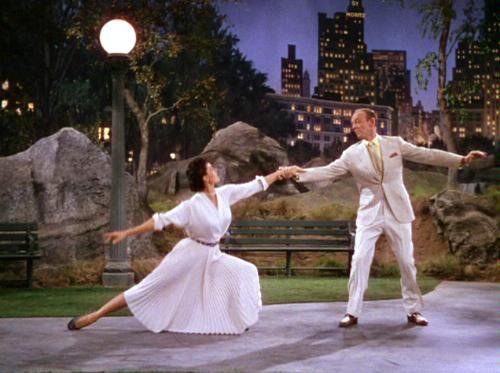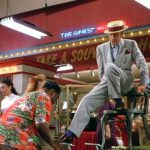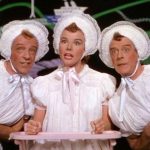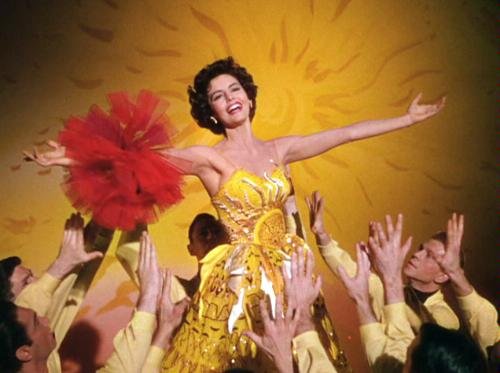![]() The Band Wagon – when an aging Hollywood dancer comes to Broadway, a couple of his playwright pals put together a musical. They’re sure it will be a hit and cast him in the lead role. Things get stressful between members of the cast. When the play has a disastrous opening night, the troupe members decide they must pull together to make the show a success.
The Band Wagon – when an aging Hollywood dancer comes to Broadway, a couple of his playwright pals put together a musical. They’re sure it will be a hit and cast him in the lead role. Things get stressful between members of the cast. When the play has a disastrous opening night, the troupe members decide they must pull together to make the show a success.
The Band Wagon (1953) Fred Astaire, Cyd Charisse, Nanette Fabray, Oscar Levant, Jack Buchanan
Review of The Band Wagon

A lot of things can be said about The Band Wagon. It’s been called the last of the great MGM musicals, and that’s probably true. It’s been called a reworking of the Faust story, and that’s partly true as well. At its’ heart, it’s the story of a once-great movie star (Fred Astaire) whose star has faded and heads back to Broadway. With the help of his friends Oscar Levant and Nanette Fabray, he gets the chance to star in a “modern” musical, directed by the delightfully, slightly crazy Jack Buchanan. He also has to face his insecurities as he dances with his prima donna co-star, Cyd Charisse. She’s too young and too tall for him.
All these things are true. But what’s most true of all is that The Band Wagon is a fun, enjoyable musical. It’s a large-scale MGM musical that’s not above poking fun at large-scale musicals. I’ve been a long-time fan of Fred Astaire, and he absolutely shines here. Although I’ll admit that the age difference between Astaire and Charisse make the romance a little awkward.
What’s not awkward is the interaction between Nanette Fabray and Oscar Levant. I’ve always enjoyed Oscar Levant, and never more than here. He’s always been enjoyable, but here he’s more of a fleshed-out character as opposed to just comedy relief. His interactions with his on-screen wife Nanette Fabray are delightful, especially when they’re “not fighting” during the rehearsals and rewrites.
Songs

- By Myself, (1937) Music by Arthur Schwartz, Lyrics by Howard Dietz
- Penny Arcade, Music by Arthur Schwartz
- A Shine on Your Shoes, (1932) Music by Arthur Schwartz, Lyrics by Howard Dietz
- National Emblem (pub. 1906) Written by Edwin Eugene Bagley
- Oedipus Bridge, Music by Arthur Schwartz, Lyrics by Howard Dietz
- That’s Entertainment (1953) Music by Arthur Schwartz, Lyrics by Howard Dietz
- The Beggars Waltz (1931) Music by Arthur Schwartz
- Dancing in the Dark (1931) Music by Arthur Schwartz
- You and the Night and the Music (1934) Music by Arthur Schwartz, Lyrics by Howard Dietz
- The Egg, Music by Arthur Schwartz
- Something to Remember You By (1930) Music by Arthur Schwartz, Lyrics by Howard Dietz
- High and Low (1931) Music by Arthur Schwartz, Lyrics by Howard Dietz
- I Love Louisa (1931) Music by Arthur Schwartz, Lyrics by Howard Dietz
- Sweet Music (1931) Music by Arthur Schwartz
- New Sun in the Sky (1931) Music by Arthur Schwartz, Lyrics by Howard Dietz
- I Guess I’ll Have to Change My Plan (1929) Music by Arthur Schwartz, Lyrics by Howard Dietz
- Louisiana Hayride (1932) Music by Arthur Schwartz, Lyrics by Howard Dietz
- Triplets (1937) Music by Arthur Schwartz, Lyrics by Howard Dietz
- The Girl Hunt (1953) Music by Arthur Schwartz
- For He’s a Jolly Good Fellow Traditional
Editorial review of The Band Wagon courtesy of Amazon.com
The Band Wagon (1953) marked the culmination of a series of near-autobiographical pictures Fred Astaire made for MGM following his return from premature retirement in the late ’40s. Astaire plays Tony Hunter, a fading film star (his big hit: Flying Down to Panama) who decides to return to his former glory, the Broadway stage. (In 1931, Astaire had starred on Broadway with sister Adele in The Band Wagon, a revue that lent some of its songs to this film.) His playwright-songwriter friends (Nanette Fabray and Oscar Levant) hook him up with Broadway’s hottest director, Jeffrey Cordova (a nicely hammy Jack Buchanan), who proves that the “new” theater traditions can be an awkward fit with the old. Hunter also finds himself at odds with his prima ballerina leading lady (Cyd Charisse), one of his chief worries being that she seems a little tall.


Along the way, producer Arthur Freed, director Vincente Minnelli, choreographer Michael Kidd, and songwriters Howard Dietz and Arthur Schwartz treat us to some quintessential MGM numbers: Astaire’s solo ode “By Myself,” the flashy arcade romp “A Shine on Your Shoes,” Astaire and Charisse’s romantic duet “Dancing in the Dark,” the faux-German drinking song “I Love Louisa,” the manic trio “Triplets” (with Astaire, Fabray, and Buchanan in matching baby outfits), the Mickey Spillane-esque “Girl Hunt Ballet,” and the classic show-biz anthem “That’s Entertainment.” Even if its ending and obligatory romance fall a little flat, The Band Wagon is one of the classic backstage musicals, a grandiose MGM spectacle that also manages to poke some fun at how grandiose MGM pictures had become. –David Horiuchi



